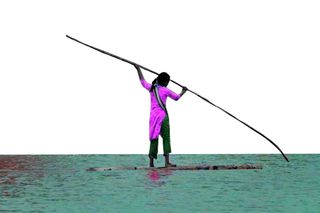
Gender‑Based Violence Increases During Floods, Extreme Weather Events: Study
Extreme events amplify “the drivers of violence or create environments that enable this type of behavior,” the researchers said.

We’re in the midst of extreme weather events globally. Floods have enveloped parts of Assam, Meghalaya, and Bangladesh; heatwaves spiked across the country; rural parts like the Marathwada and Vidarbha region in Maharashtra have witnessed a series of droughts, cyclones, and heatwaves in relentless succession. Climate change is causing some staggering changes in ecologies, but new research also suggests that it is fueling violence against gender and sexual minorities globally too.
Published last week in The Lancet Planetary Health, the study indicated that violence against women, queer communities, and other gender and sexual minorities increase during these extreme weather events caused due to climate change. The imprints of changes in climatic conditions are staggering and stark: over the last 20 years, the frequency of floods has increased by 134% globally, droughts by 29%, and storms by 40%, the study pointed out. As we speak, floods and landslides are threatening the life, livelihood, and health of thousands of people across Assam and Meghalaya.
“When we think of climate change effects, we think of some very drastic and very visual things, things like floods, disruptions of cities, supply chain disruptions — which are all very valid and very real risks of climate change,” said Sarah Savić Kallesøe, a public health researcher at Simon Fraser University in Canada. “But there are also some more veiled consequences that are not as easily visible or easily studied. And one of those things is gender-based violence.”
Savić Kallesøe, along with others, co-authored a review of pre-existing literature (approximately 41 research papers) on extreme weather events across five continents. These include everything from floods, droughts, and storms to fires and heatwaves. The frequency and severity of these events were analyzed to map the trajectory of gender-based violence, tracking instances of rape, sexual assault, child marriages, and “witch killings.”
The intensity of disasters is perilous, and will only increase to be so. When understood through the gender lens, the trend becomes murkier: that women, girls, and minorities will suffer more due to ecological catastrophe. This knowledge and insight are then critical to any disaster relief organizations that governments and humanitarian organizations carry out.
The visible toll of weather disasters, such as torn-down buildings and buckled roads, “can overshadow more veiled consequences, including gender-based violence experienced by women, girls, and sexual and gender minorities,” Kim van Daalen, lead study author and a researcher at the University of Cambridge’s Department of Public Health and Primary Care and lead author of the analysis, told Insider.
Related on The Swaddle:
Why Women Activists Never Get Their Due Despite Being Critical to Nature Conservation
There is no direct causation between extreme weather events and say rape against women. But each and every cyclone, flood, and heatwaves orchestrates unequal conditions that come at the detriment of people who are already marginalized and discriminated against. These instances become “drivers of violence.” If social order is a big, unstable pile of Jenga, climate change-fueled weather catastrophes pull multiple blocks out in a haphazard fashion. The Jenga shake-up similarly happens in instances of conflicts and other humanitarian crises. The instability is disproportionately borne by sections of society structurally marginalized.
This can happen during, and in the aftermath, of the climate disaster. “The shelter is not safe for us. Young men come from seven or eight villages,” one survivor told the researchers following Cyclone Roanu in Bangladesh in 2016. “I feel frightened to stay in the shelters. I stay at my house rather than taking my teenage daughter to the shelters,” she added. In five studies the researchers reviewed, drought in sub-Saharan Africa was linked to sexual and physical violence by intimate partners, along with a rise in child marriage and dowry violence. The series of displacement and economic stress can force families to marry off girls early and cut their access to education. Even conditions of relief camps create situations where people may be exposed to violence by strangers and officials alike.
“At the root of this behavior are systematic social and patriarchal structures that enable and normalize such violence,” van Daalen said.
There have been hints, anecdotes, and some tepid data on how climate change disasters are already impacting socially and economically vulnerable sections of society. The migration and displacement across the Sundarbans are but one such example. A 2018 report suggests that by 2050, without concrete climate action, over 40 million people across South Asia could be forced to move within their own countries to escape the impact of climate change. Locals are caught in an endless cycle of building homes and defending their lands in the face of endless devastation. “It seems like we’re running, and it’s on the chase,” as Sapan Naskar, 46, told The Swaddle. Climate change is exacerbating poverty and living conditions; a similar cycle seems to be playing out for gender-based inequalities.
What this research highlights is a clear demarcation of evidence: of the overlap in the Venn diagram of gender inequality and climate disasters. “Gender-based violence is happening all the time, everywhere,” said Lindsay Stark, a social epidemiologist at the Brown School of the Washington University in St. Louis. “We need to be preventing gender-based violence now… and to understand that if we don’t act now, the situation is going to increase exponentially with the impending climate crisis that we all know is upon us.”
Gender-based violence is a violent storm of its own that has intensified over the course of the pandemic. Climate mitigation, then, must address a systemic problem from within the system itself. Disaster management — which includes prevention and mitigation of weather catastrophes — must keep into account drivers of gender-based violence.
“It’s crucial that [disaster management response is] informed by the women, girls, and sexual and gender minority populations affected and takes into account local sexual and gender cultures and local norms, traditions, and social attitudes,” van Daalen said.
Saumya Kalia is an Associate Editor at The Swaddle. Her journalism and writing explore issues of social justice, digital sub-cultures, media ecosystem, literature, and memory as they cut across socio-cultural periods. You can reach her at @Saumya_Kalia.
Related


PUBG’s Parent Company Unveils Latest ‘Virtual Influencer’ Ana. What’s the Cost?
